
The semipalmated sandpiper is a very small shorebird. The genus name is from Ancient Greek kalidris or skalidris, a term used by Aristotle for some grey-coloured waterside birds. The specific pusilla is Latin for "very small".

Baillon's crake, also known as the marsh crake, is a small waterbird of the family Rallidae.
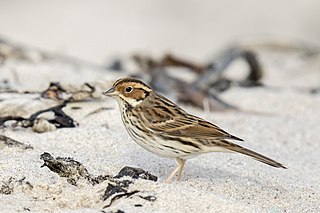
The little bunting is a passerine bird belonging to the bunting family (Emberizidae).

The field sparrow is a small New World sparrow in the family Passerellidae. It is about 140 mm (6 in) long and weighs about 12.5 g (0.4 oz). The head is grey with a rust-coloured crown, white eye-ring and pink bill. The upper parts are brown streaked with black and buff, the breast is buff, the belly is white and the tail is forked. There are two different colour morphs, one being greyer and the other more rufous.

The Senegal eremomela is a member of the African warbler family, the Cisticolidae. It occurs in the savannas of western Sub-Saharan Africa.

The brown-headed nuthatch is a small songbird endemic to pine forests throughout the Southeastern United States. Genetic analyses indicated low differentiation between northern and southern populations in Florida, but the study also found lower genetic diversity among south Florida populations that may be a result of the increased habitat fragmentation that was documented. The Bahama nuthatch was formerly considered a subspecies (S. p. insularis), has since been reclassified as its own separate species. Two recent studies assessing vocalizations in Bahama and continental nuthatch populations found important differences. One of the studies also demonstrated that continental and Bahama populations did not respond aggressively to calls of the other population. This type of call-response study is often used to help define cryptic species.

The least auklet is a seabird and the smallest species of auk. It is the most abundant seabird in North America, and one of the most abundant in the world, with a population of around nine million birds. They breed on the islands of Alaska and Siberia, and spend the winter close to the edge of the ice sheet. Their largest colonies are on the Aleutian Islands, St. Lawrence Island and Little Diomede Island.
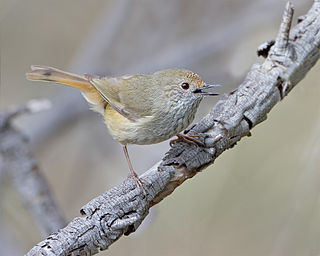
The brown thornbill is a passerine bird usually found in eastern and south-eastern Australia, including Tasmania. It can grow up to 10 cm (3.9 in) long, and feeds on insects. It is brown, grey and white. The species has five subspecies.
The least big-eared bat is a bat species of the family Phyllostomidae, found in northwestern Brazil and eastern Colombia. It is the only species within its genus.

The southern little yellow-eared bat is a frugivorous bat species found in Brazil, Argentina and Paraguay.

The Chatham snipe or Chatham Island snipe is a species of wader in the family Scolopacidae. It is endemic to the Chatham Islands of New Zealand, and is only found on a few islands in the south of the Chatham Islands group.

The barred cuckooshrike, also called the yellow-eyed cuckooshrike, is a species of bird in the family Campephagidae. It is found in eastern Australia, Indonesia, Papua New Guinea, and Solomon Islands.
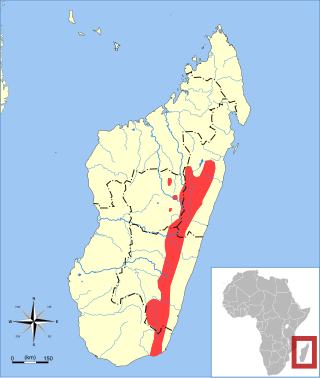
The least shrew tenrec is a species of mammal in the family Tenrecidae. It is endemic to Madagascar. Its natural habitats are subtropical or tropical moist forests, swamps, pastureland, and irrigated land.

The steppe pika is a small mammal of the pika family, Ochotonidae. It is found in the steppes of southern Russia and northern Kazakhstan.
The Nullarbor dwarf bettong, Bettongia pusilla, was a potoroine marsupial that occurred in Australia. The animal is only known from skeletons found in caves of the Nullarbor Plain and is now classified as recently extinct.
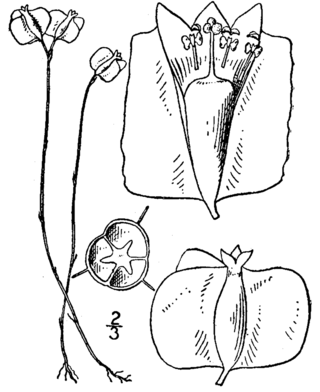
Burmannia biflora, common name northern bluethread, is a plant species native to Cuba, the Bahamas and to the southeastern United States. It has been reported from Puerto Rico, eastern Texas, Louisiana, southwestern Arkansas, southern Mississippi, southern Alabama, Florida, Georgia, South Carolina, North Carolina and southeastern Virginia.

Burmannia coelestis is a partially mycoheterotrophic species of plant in the genus Burmannia. It is widespread, occurring in South to Southeast Asia, New Guinea, Australia, and in Micronesia. It is usually found in wet places, such as in marshes, swamps, and around the edges of pools.
Burmannia disticha is a species of plant that is occasionally seen in South and Southeast Asia, Australia, and New Guinea. It is found in freshwater systems and can grow in swamps, boggy areas, and wet rocks.
Burmannia grandiflora is a flowering plant in the family Burmanniaceae found in Colombia, central Brazil, and Bolivia. It grows mostly on wet savannas, sandy soil, from sea level to a height of 1230 meters.
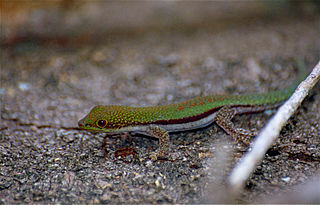
Phelsuma pusilla, the lesser day gecko, is a species of gecko found in Madagascar.
















